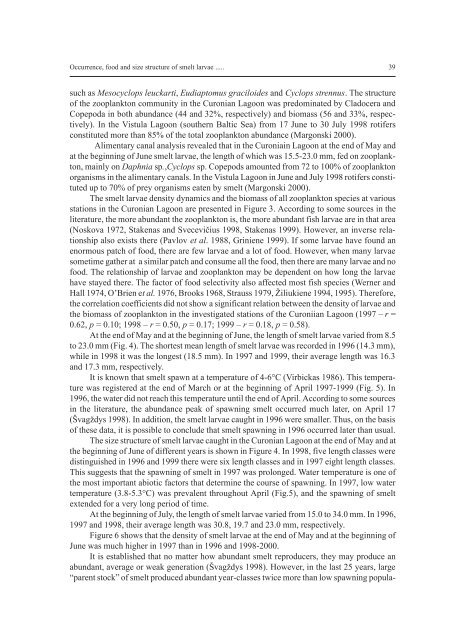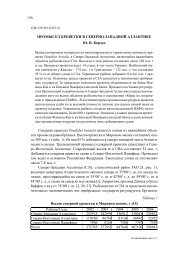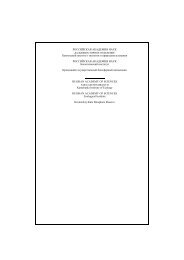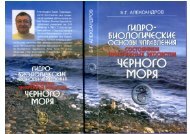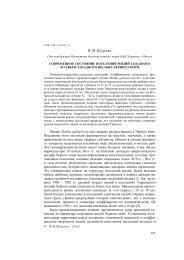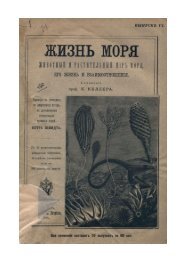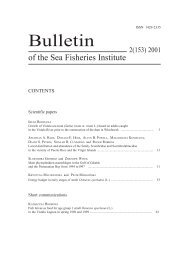Bulletin of the Sea Fisheries Institute 2 (156) 2002 - CEEMaR
Bulletin of the Sea Fisheries Institute 2 (156) 2002 - CEEMaR
Bulletin of the Sea Fisheries Institute 2 (156) 2002 - CEEMaR
You also want an ePaper? Increase the reach of your titles
YUMPU automatically turns print PDFs into web optimized ePapers that Google loves.
Occurrence, food and size structure <strong>of</strong> smelt larvae ..... 39<br />
such as Mesocyclops leuckarti, Eudiaptomus graciloides and Cyclops strennus. The structure<br />
<strong>of</strong> <strong>the</strong> zooplankton community in <strong>the</strong> Curonian Lagoon was predominated by Cladocera and<br />
Copepoda in both abundance (44 and 32%, respectively) and biomass (56 and 33%, respectively).<br />
In <strong>the</strong> Vistula Lagoon (sou<strong>the</strong>rn Baltic <strong>Sea</strong>) from 17 June to 30 July 1998 rotifers<br />
constituted more than 85% <strong>of</strong> <strong>the</strong> total zooplankton abundance (Margonski 2000).<br />
Alimentary canal analysis revealed that in <strong>the</strong> Curoniain Lagoon at <strong>the</strong> end <strong>of</strong> May and<br />
at <strong>the</strong> beginning <strong>of</strong> June smelt larvae, <strong>the</strong> length <strong>of</strong> which was 15.5-23.0 mm, fed on zooplankton,<br />
mainly on Daphnia sp.,Cyclops sp. Copepods amounted from 72 to 100% <strong>of</strong> zooplankton<br />
organisms in <strong>the</strong> alimentary canals. In <strong>the</strong> Vistula Lagoon in June and July 1998 rotifers constituted<br />
up to 70% <strong>of</strong> prey organisms eaten by smelt (Margonski 2000).<br />
The smelt larvae density dynamics and <strong>the</strong> biomass <strong>of</strong> all zooplankton species at various<br />
stations in <strong>the</strong> Curonian Lagoon are presented in Figure 3. According to some sources in <strong>the</strong><br />
literature, <strong>the</strong> more abundant <strong>the</strong> zooplankton is, <strong>the</strong> more abundant fish larvae are in that area<br />
(Noskova 1972, Stakenas and Svecevièius 1998, Stakenas 1999). However, an inverse relationship<br />
also exists <strong>the</strong>re (Pavlov et al. 1988, Griniene 1999). If some larvae have found an<br />
enormous patch <strong>of</strong> food, <strong>the</strong>re are few larvae and a lot <strong>of</strong> food. However, when many larvae<br />
sometime ga<strong>the</strong>r at a similar patch and consume all <strong>the</strong> food, <strong>the</strong>n <strong>the</strong>re are many larvae and no<br />
food. The relationship <strong>of</strong> larvae and zooplankton may be dependent on how long <strong>the</strong> larvae<br />
have stayed <strong>the</strong>re. The factor <strong>of</strong> food selectivity also affected most fish species (Werner and<br />
Hall 1974, O’Brien et al. 1976, Brooks 1968, Strauss 1979, Žiliukiene 1994, 1995). Therefore,<br />
<strong>the</strong> correlation coefficients did not show a significant relation between <strong>the</strong> density <strong>of</strong> larvae and<br />
<strong>the</strong> biomass <strong>of</strong> zooplankton in <strong>the</strong> investigated stations <strong>of</strong> <strong>the</strong> Curoniian Lagoon (1997 – r =<br />
0.62, p = 0.10; 1998 – r = 0.50, p = 0.17; 1999 – r = 0.18, p = 0.58).<br />
At <strong>the</strong> end <strong>of</strong> May and at <strong>the</strong> beginning <strong>of</strong> June, <strong>the</strong> length <strong>of</strong> smelt larvae varied from 8.5<br />
to 23.0 mm (Fig. 4). The shortest mean length <strong>of</strong> smelt larvae was recorded in 1996 (14.3 mm),<br />
while in 1998 it was <strong>the</strong> longest (18.5 mm). In 1997 and 1999, <strong>the</strong>ir average length was 16.3<br />
and 17.3 mm, respectively.<br />
It is known that smelt spawn at a temperature <strong>of</strong> 4-6°C (Virbickas 1986). This temperature<br />
was registered at <strong>the</strong> end <strong>of</strong> March or at <strong>the</strong> beginning <strong>of</strong> April 1997-1999 (Fig. 5). In<br />
1996, <strong>the</strong> water did not reach this temperature until <strong>the</strong> end <strong>of</strong> April. According to some sources<br />
in <strong>the</strong> literature, <strong>the</strong> abundance peak <strong>of</strong> spawning smelt occurred much later, on April 17<br />
(Švagždys 1998). In addition, <strong>the</strong> smelt larvae caught in 1996 were smaller. Thus, on <strong>the</strong> basis<br />
<strong>of</strong> <strong>the</strong>se data, it is possible to conclude that smelt spawning in 1996 occurred later than usual.<br />
The size structure <strong>of</strong> smelt larvae caught in <strong>the</strong> Curonian Lagoon at <strong>the</strong> end <strong>of</strong> May and at<br />
<strong>the</strong> beginning <strong>of</strong> June <strong>of</strong> different years is shown in Figure 4. In 1998, five length classes were<br />
distinguished in 1996 and 1999 <strong>the</strong>re were six length classes and in 1997 eight length classes.<br />
This suggests that <strong>the</strong> spawning <strong>of</strong> smelt in 1997 was prolonged. Water temperature is one <strong>of</strong><br />
<strong>the</strong> most important abiotic factors that determine <strong>the</strong> course <strong>of</strong> spawning. In 1997, low water<br />
temperature (3.8-5.3°C) was prevalent throughout April (Fig.5), and <strong>the</strong> spawning <strong>of</strong> smelt<br />
extended for a very long period <strong>of</strong> time.<br />
At <strong>the</strong> beginning <strong>of</strong> July, <strong>the</strong> length <strong>of</strong> smelt larvae varied from 15.0 to 34.0 mm. In 1996,<br />
1997 and 1998, <strong>the</strong>ir average length was 30.8, 19.7 and 23.0 mm, respectively.<br />
Figure 6 shows that <strong>the</strong> density <strong>of</strong> smelt larvae at <strong>the</strong> end <strong>of</strong> May and at <strong>the</strong> beginning <strong>of</strong><br />
June was much higher in 1997 than in 1996 and 1998-2000.<br />
It is established that no matter how abundant smelt reproducers, <strong>the</strong>y may produce an<br />
abundant, average or weak generation (Švagždys 1998). However, in <strong>the</strong> last 25 years, large<br />
“parent stock” <strong>of</strong> smelt produced abundant year-classes twice more than low spawning popula-


